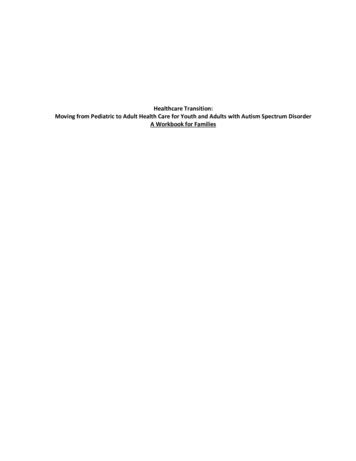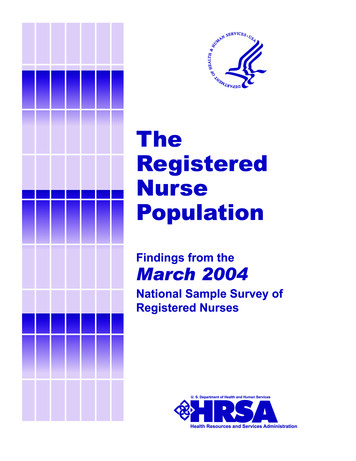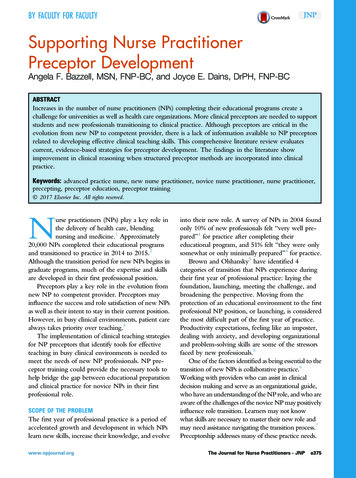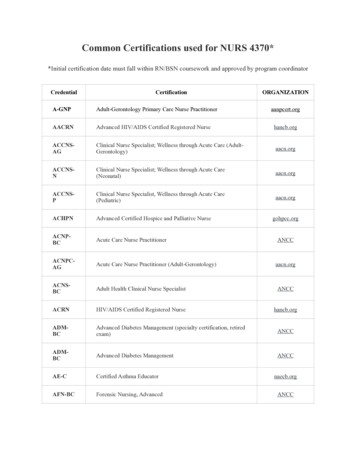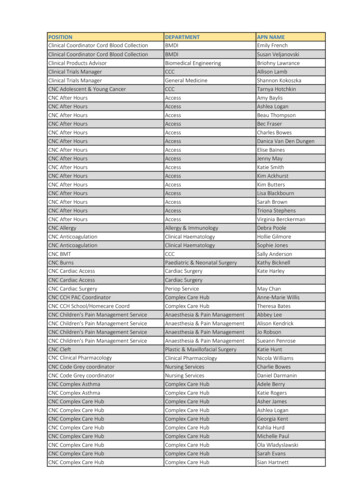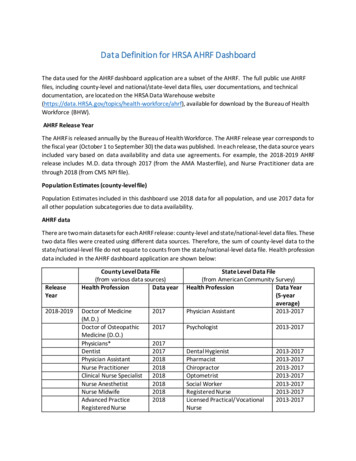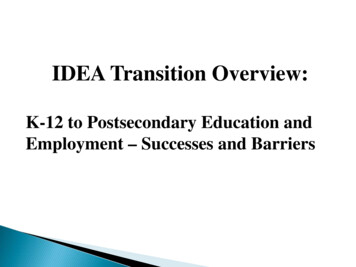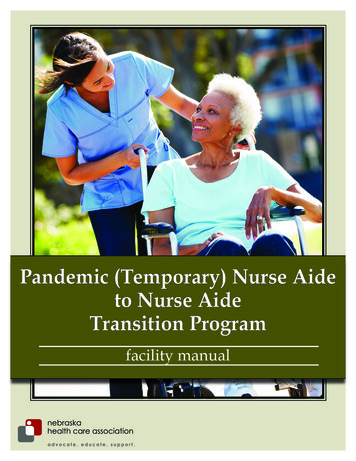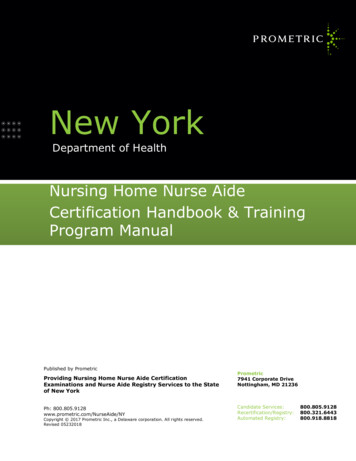
Transcription
Krall et al. Clinical Diabetes and Endocrinology (2016) 2:1DOI 10.1186/s40842-016-0020-1RESEARCH ARTICLEOpen AccessThe Nurse Education and Transition (NEAT)model: educating the hospitalized patientwith diabetesJodi Stotts Krall1*, Amy Calabrese Donihi2, Mary Hatam3, Janice Koshinsky1,3 and Linda Siminerio4AbstractBackground: The number of patients with a diabetes mellitus (DM)-related diagnosis is increasing, yet the numberof hospital-based diabetes educators is being reduced. Interest in determining effective ways for staff nurses todeliver diabetes education (DE) is mounting. The purpose of this multi-phase feasibility study was to develop andevaluate the Nurse Education and Transition (NEAT) inpatient DM education model.Methods: Exploratory focus groups were conducted with staff nurses from inpatient units at academic tertiaryand community hospitals to gain insight into barriers, content, delivery and support mechanisms related toproviding DE to hospitalized patients. Findings informed the development of the NEAT model, whichincluded a delivery protocol and toolkit with brief educational videos on key diabetes topics uploaded ontoiPads, patient assessments and “teach back” tools, a discharge survival skills summary sheet, and guidelines forelectronic medical record documentation and scheduling outpatient DE visits. Trained staff nurses used NEATto deliver DE to hospitalized patients with DM and then participated in follow-up focus groups to assess theirexperiences, with particular attention to the usefulness of NEAT in meeting the needs of nurses related to thedelivery of diabetes survival skill education. Information generated was analyzed to identify emerging keythemes.Results: Exploratory focus groups revealed that staff nurses view teaching patients with DM as part of theirjob, but report barriers. Nurses agreed that inpatient DE should be designed to assure safety after dischargeand advised that it be patient-centered, targeted, assessment-based and user friendly. Nurses who participatedin the delivery of NEAT found that the process and tools met the majority of the basic DE needs of theirpatients while relieving their workload. In particular, they reported that video and iPad technology provided aconvenient and standardized method for facilitating teaching at the bedside, but requested that aninteractive feedback mechanism be added to encourage patient self-knowledge assessment.Conclusions: This study presents challenges staff nurses face in providing DE to hospitalized patients andidentifies opportunities and strategies for improving content and delivery to ensure safe transition of patientswith DM from hospital to outpatient setting.Keywords: Education, Hospital, Inpatient, Nurse* Correspondence: stottsj@upmc.edu1University of Pittsburgh Diabetes Institute, 4401 Penn Avenue, LMB Room2112, Pittsburgh, PA 15224, USAFull list of author information is available at the end of the article 2016 Krall et al. Open Access This article is distributed under the terms of the Creative Commons Attribution 4.0International License (http://creativecommons.org/licenses/by/4.0/), which permits unrestricted use, distribution, andreproduction in any medium, provided you give appropriate credit to the original author(s) and the source, provide a link tothe Creative Commons license, and indicate if changes were made. The Creative Commons Public Domain Dedication o/1.0/) applies to the data made available in this article, unless otherwise stated.
Krall et al. Clinical Diabetes and Endocrinology (2016) 2:1BackgroundPeople with diabetes mellitus (DM) are more likely to behospitalized and have longer length of stay (LOS) thanthose without DM [1]. A recent survey estimated that22 % of all hospital inpatient days were incurred bypeople with DM [2] and that inpatient care accounts for43 % of the total medical costs of diabetes [3]. Becausethe proportion of hospitalized patients with diabetes hasrisen steadily over recent decades in tandem with the increasing incidence of diabetes in the general population[4], these rates may continue to climb [5]. It is nosurprise that interest is growing in determining ways toimprove hospital management with evidence-based protocols [6–8] and a Transition of Care Coalition [9],established to develop approaches to assure a safe transition following discharge. The Joint Commission onHospital Accreditation and the American DiabetesAssociation (ADA) recommend that inpatient programsspecifically include staff training and patient selfmanagement education [9].DM is a complex chronic disease that requires theperson with DM to make a multitude of daily selfmanagement decisions and perform numerous care activities. After a hospital stay, patients often face addedchallenges regarding diabetes management. Some patients may receive a new diagnosis of DM while thosediagnosed are likely to have their treatment plansadapted. For example, those formerly taking oral antihyperglycemic medications may start insulin injections, or have their monitoring, activity or nutritionplans changed, all of which require extensive education so that a patient can self-manage their conditionupon discharge [10].Diabetes self-management education (DSME) providesthe foundation for self-care and helps people living withDM navigate daily decisions and activities. DSME hasbeen shown to improve health outcomes and reducehospital readmissions and costs [11–14]. It is recommended that all patients with DM receive DSME [10].An audience of hospitalized patients offers an opportunity to reach people with DSME and for many years diabetes educators were employed to provide this inpatientservice.However, it has been shown that attempts in providingcomprehensive DSME during a hospital stay are oftenineffective for a number of reasons [15, 16]. A hospitalstay does not always afford a “teachable” moment,” givenhospitalized patients are acutely ill and have competingdemands like scheduled procedures [15]. The increasingnumber of people with DM [4] and limited hospitallength of stay (LOS) [17], presents additional challengesfor providing comprehensive DSME to a large numberof patients during a brief hospital admission. Nevertheless, educating hospitalized patients is considered to bePage 2 of 6important, and many institutions are re-examining thedelivery during a hospital stay and the role of dedicatededucators to provide this service. More recently, healthsystems are adopting models where diabetes educationin the hospital solely focuses on survival skills, including hypoglycemia, medication education, nutrition, and blood glucose monitoring [15, 18, 19], anddetailed DSME is typically deferred to the outpatientarena.Hospital bedside nurses are expected to provide the“survival skills” education, but are often unprepared andoverwhelmed with many other responsibilities. As a result, education tends to be inadequate and fragmented.Patients often leave the hospital without the self-careskills and follow up referral to DSME that can result insubsequent problems, like readmission [18]. Thus, interest in determining effective ways for staff nurses to provide basic DSME education and address transition ondischarge is mounting. Despite reports on effective inpatient education programs [17, 20–22], no standardized, evidence-based programs have been developed fortraining bedside nurses in DM education and transition.The objectives of this multi-phase, feasibility studywere to (1) explore staff nurse perceptions of their roleand experiences in providing education to hospitalizedpatients with DM, and, based on these findings, (2) develop and assess the feasibility of the Nurse Educationand Transition (NEAT) inpatient DM education model.MethodsRecruitment and settingsNurses (n 26) from 11 inpatient units at an academictertiary and two community hospitals were recruited toparticipate in the NEAT study, which took place over a9-month period. Nurse leadership at the respective institutions were presented with the program and asked toidentify hospital units where nurses were routinelyexpected to educate patients with DM. This project wasapproved as a Quality Improvement project (Project#0001512) by the UPMC Quality Review Committee.Phase 1: Exploratory focus groupsA series of focus group meetings were scheduled withregistered nurses on various units to explore nurse insights regarding educating hospitalized patients withDM. Trained members of the research team presentedscripted questions and examples of current educationmaterials, including hand-outs, videos, and knowledgebased questionnaires to the nurses. Nurses were askedto provide their opinion about inpatient diabetes education in terms of barriers, content, delivery and supportmechanisms. Nurse responses were transcribed andanalyzed by trained members of the research team toidentify emerging key themes.
Krall et al. Clinical Diabetes and Endocrinology (2016) 2:1Page 3 of 6Phase 2: Designing and evaluating NEATTable 2 NEAT protocolFocus group findings identified key elements (Table 1)and informed development of a structured deliveryprotocol (Table 2) and tools to guide staff nurses in providing patient-centered “survival skill” education to assure safety after hospitalization and transition to existingoutpatient diabetes education. Easy to use patient assessments were developed to capture information that is inaccordance with the National Standards for DSME/Sand DSME program recognition [23, 24]. In collaboration with nurses, the research team developed and/orselected already available brief, short video vignettes onkey diabetes topics: nutrition, activity, insulin administration, injection techniques, and risk reduction inregards to hypo- and hyperglycemia. Video contentaligned with guidance from the American Association ofDiabetes Educators’ “AADE7 Self-Care Behaviors ” [25]and was based on the feedback from the nurse focusgroup discussions. Videos were uploaded onto iPads inorder to provide a user-friendly, efficient mechanismfor education delivery. In addition, “teach back” tools,a standardized approach to diabetes education for electronic medical record (EMR) documentation across internal institutions and units, and a discharge survival skillssummary sheet were designed. Nurses were identified onspecific hospital units to deliver NEAT and trained toschedule outpatient DSME visits for patients prior to hospital discharge. Nurses were instructed to follow theprotocol to implement NEAT in their respective unitswith those patients who they identified in need of education and able to participate. During the course of programimplementation, the research team provided study andtechnological support to the participating nurses. After aperiod of use, during which the NEAT model was used todeliver education to approximately 25 patients, the research team held focus groups with staff at each of theparticipating hospitals to assess their experiences usingNEAT, with particular attention to its usefulness in meeting the needs of staff related to the delivery of diabetessurvival skill education.1. Assess patient diabetes self-management needsTable 1 NEAT key elements Brief video vignettes focused on diabetes self-management “survivalskills”o Nutritiono Medication takingo Insulin injectionso Blood glucose monitoringo Hypoglycemia Patient knowledge assessment Nurse “cheat” sheet to aid in patient knowledge acquisition Survival skills take home sheet Diabetes education resource list to aid in scheduling outpatient visitsprior to discharge Uniform documentation guidance in electronic medical record2. Prioritize learning needs critical to assuring a safe transition to home,e.g., injection skills, identifying and treating hypoglycemia, emergencycall numbers, etc.3. Select appropriate videos accordingly.4. Deliver and review video/iPad with patient5. Assess knowledge through teach back with quiz6. Provide patient/caregivers with “Survival Skill” take home sheet7. Make appointment for diabetes educator on discharge8. Document in the electronic medical recordResultsPhase 1Staff nurses viewed teaching DM patients as part of theirjob, but reported barriers: lack of time/resources andguidance on expectations (“What are we expected to doand accomplish?”), shortened LOS and caring for sickerpatients who require their attention for pain management and are often sedated. In addition the nurses’shared their lack of confidence in providing accurate information on current therapies/tools and fear that patients will ask questions that they cannot answer, thusjeopardizing patient trust. Nurses agreed that educationwas important and should be designed to assure safetyafter discharge, focusing on “survival skills” related tohypoglycemia, medication, nutrition, and blood glucosemonitoring, and directing patients to outpatient DSME.They advised that DSME should be patient-centered,targeted, assessment-based and user-friendly to accommodate sicker patients and health literacy. Nurses recommended developing brief videos with iPads or similartechnology to facilitate delivery of survival skill education. Ideas for supporting staff nurses were access to adietitian; resource nurse and/or centralized diabetes educator (most reasonably the hospital outpatient educator)for more complex cases; easily accessible, routinelyupdated, to-the-point web-based information and incentives for maintaining diabetes-related competencies. Nurses encouraged EMR enhancements to simplifycharting, provide survival skills discharge educationaltools and improve care coordination with outpatientDSME services.Phase 2Nurses who participated in the delivery of NEAT reported that the program met the goal of providingpatient-centered diabetes survival skills, particularly forintroducing patients to therapies and devices andreviewing dietary considerations. They reported that thevideos embedded on the iPads provided a convenientand standardized method for facilitating teaching at thebedside. All agreed that a video modality was a useful
Krall et al. Clinical Diabetes and Endocrinology (2016) 2:1mechanism for meeting the needs of hospitalized patients who are unwell and those with health literacy issues. The video format also afforded the opportunity forpatients to view and review educational presentations attimes convenient for them. No problems were reportedwith patient’s ability to use the iPad technology and several nurses found that patients reported liking this modality. Moreover, the NEAT approach relieved pressurefrom the staff nurses’ workload. Overall, nurses foundthe protocol easy to follow and commented that itallowed for a standardized, yet tailored approach to survival skill education. Some challenges and opportunitiesfor improvement were noted too. Nurses thought itwould be beneficial to add an interactive feedback mechanism to the video to allow patients to self-assess knowledge after viewing videos. They also thought it wouldbe beneficial to engage caregivers when appropriate. Inaddition, most found it challenging to schedule visitswith an outpatient educator prior to discharging patients, with the most frequently cited issue being uncertainty as to whether the education would be covered bythe patient’s insurance plan.DiscussionIt is often the case that health care services are recommended and expected to be provided without gaining insights from the very people who are presumed to deliverthem. In this report, we demonstrate that NEAT –developed based on information gathered from nurseswho are expected to deliver inpatient DM education - isa useful program for bedside nurses in providing survivalskill education for the hospitalized patient with DM.Bedside nurses found that the NEAT process and toolsmet the majority of the basic diabetes education needsof their patients while relieving their workload.This study also reaffirms challenges that bedsidenurses’ face [15, 16] and identifies opportunities andstrategies for improving content and delivery. Althoughbedside nurses do see patient education as part of theirjob, competing demands, high acuity level of patientsnow admitted to the hospital, their limited self-knowledgeregarding new therapies and tools and confusion regarding teaching expectations serve as barriers to successfullycarrying out this responsibility. Increasingly, hospital LOSis becoming shorter with discharge dates often determinedby payers. This creates additional problems in planningfor the delivery of inpatient education when predetermined discharge schedules are not made available. Nursesfacing these challenges do appreciate diabetes educatorsand dietitians as resources, believe that technological approaches should be explored and that comprehensiveDSME is essential but should occur in the outpatient setting. The nurses’ message is consistent with others whofind that providing diabetes education for safe transitionPage 4 of 6to home is critically important and [15, 18, 19, 26, 27]given the large number of hospitalized patients with diabetes, the focus for inpatient education will need to be onsurvival skill training [15, 18].Findings from this study also corroborate those of aprevious qualitative study where investigators exploringcauses for readmission in people with DM found reoccurring themes that emerged as contributors to readmission risk [28]. Themes that can be addressedthrough DSME included patient poor health literacy(lack of knowledge about diabetes and discharge instructions); failure to follow discharge instructions; lack ofawareness of medication changes, limited social support;and loss of control over illness. To reduce the readmission risk for DM patients, the investigators recommended that survival skills education address sick daycare and recognition, treatment, and prevention ofhyperglycemia and hypoglycemia, as well as the logisticsof taking diabetes medications [28]. They reiterated theneed for staff nurses with discharge instruction to refer tooutpatient DSME that offers the advantages of ongoingmanagement, inclusion of family support, a teachable moment and a patient-centered approach.Given that the number of people who receive DSMEand provider referrals continues to be low, innovativeapproaches to promote follow up DSME services arenecessary [29, 30]. A recent position statement jointlyissued by the American Diabetes Association, theAmerican Association of Diabetes Educators, and theAcademy of Nutrition and Dietetics [10] acknowledged the need for a systematic referral process topromote uptake of DSME services. To this end, anevidence-based diabetes education algorithm was developed to provide guidance on when, what, and howDSME/S should be provided. As might be expected,DSME is recommended when factors present that may influence self-management, including a transition from hospital to home. Mechanisms to assure automatic referralsto DSME, possibly through EMRs, upon hospital discharge need to be improved. In addition, physicians working in hospitals like hospitalists need to be informed aboutreferrals and the benefits of outpatient DSME.In addition, resources need to be directed to supportthe use of technology. In another study of inpatient education, educating hospitalized patients about warfarin byusing a video on an iPad was shown to be effective [31].The pharmacists leading this study conclude that videoeducation on an iPad may be an alternative to traditionaleducation in the hospital setting. Nurses in the NEATstudy also support the use of iPads as a technologybased approach for delivery.Like other hospital health systems facing the challengeof a growing DM population and inverse number of available certified diabetes educators (CDEs) and resources
Krall et al. Clinical Diabetes and Endocrinology (2016) 2:1[18, 32], the study institution has implemented a systemwide model whereby trained diabetes resource nursesfocus on providing staff education and assessing competency, while staff nurses educate the patient on basic skillsand content during the hospital stay. The ultimate goal isto use “precious” education resources wisely. CDEs, whoalso serve the outpatient population, are charged withproviding support and training for hospital staff onnew diabetes therapies, protocols, education strategiesand for those inpatients identified to have morechallenging/complex diabetes education needs. At thetime of discharge, the aim is that patients have received education on survival skills and are connectedto follow-up in outpatient medical management andoutpatient education. Tracking actual participation inthe DSME service is underway.The limitations of this project are recognized. NEATis a qualitative feasibility study designed to elicit reactions from nurses. Findings are representative of nurseswho work within the same hospital system, althoughthe nurses did represent academic and communitybased hospitals. The study did not include a controlgroup, as it would have been unethical to deny diabeteseducation to patients [33]. Study obligations and timelines limited opportunity for large scale patient recruitment and assessment of patient-level outcomes. TheNEAT implementation was dependent on the availability of current nurse staffing and patient loads. For example, engaging nurses when they were caring for a fullpatient load was difficult and limiting. Recognition isalso given to the need to attend to psychosocial issues.For example, distress levels are reported to be high atDM diagnosis [34]. This should apply to those newlydiagnosed during a hospitalization. Acuity and effortsto address patient needs such as pain managementare often the priority of bedside nurses duringhospitalization. However, there may be opportunitiesto integrate methods for assessing and addressingpsychosocial issues, at least in a limited capacity, andthis should be explored in future research.ConclusionsWith the growing number of people with DM andtheir need for self-management education, health systems would be wise to consider programs that address the needs of hospitalized patients with DM andthe staff that are expected to provide their care.Messages from front line nurses providing these services need to be taken seriously. Hospital leadershipshould set clear expectations that inpatient educationfor patients with DM be funneled to the provision ofsurvival skill education. Nurses with competing demands and limited opportunities for training ondiabetes–specific topics should not be expected toPage 5 of 6provide comprehensive DSME. Those keen to preventhospital readmissions, should strongly consider improving resources and access to outpatient diabeteseducation. The need for evidence-based standardizedinpatient education processes is warranted.Competing interestsNo competing interests exist.Authors’ contributionsJSK and LS contributed to study concept and design, performed dataanalysis and interpretation, and drafted/reviewed the manuscript. ACD, MH,and JK contributed to study design and reviewed/edited the manuscript. Allauthors read and approved the final manuscript.AcknowledgmentsThis article represents independent research supported by a grant from theBeckwith Institute. We thank Cynthia Donovan and Justin Kanter who helpeddesign and facilitate the project and the nurses and patients whoparticipated in this study.Author details1University of Pittsburgh Diabetes Institute, 4401 Penn Avenue, LMB Room2112, Pittsburgh, PA 15224, USA. 2School of Pharmacy, University ofPittsburgh, Pittsburgh, PA, USA. 3University of Pittsburgh Medical Center,Pittsburgh, PA, USA. 4Department of Medicine, University of Pittsburgh,Pittsburgh, PA, USA.Received: 20 October 2015 Accepted: 10 January 2016References1. Selby JV, Ray GT, Zhang D, Colby CJ. Excess costs of medical care forpatients with diabetes in a managed care population. Diabetes Care.1997;20:1396–402.2. Fraze T, Jiang HJ, Burgess J. Hospital stays for patients with diabetes,2008: Statistical Brief #93. In: Healthcare Cost and Utilization Project (HCUP)Statistical Briefs [Internet]. Rockville (MD): Agency for Healthcare Researchand Quality (US); 2006–2010.3. American Diabetes Association. Economic costs of diabetes in the U.S. in2012. Diabetes Care. 2013;36:1033–46.4. Centers for Disease Control and Prevention: Number (in thousands) ofhospital discharges with diabetes as any-listed diagnosis, United States,1988–2009. .htm]5. Pfuntner A, Wier LM, Steiner C. Costs for hospital stays in the United States,2011: Statistical Brief #168. In: Healthcare Cost and Utilization Project (HCUP)Statistical Briefs [Internet]. Rockville (MD): Agency for Healthcare Researchand Quality (US); 2013.6. DiNardo M, Donihi AC, DeVita M, Siminerio L, Rao H, Korytkowski M.Nurse-directed protocol for recognition and treatment of hypoglycemia inhospitalized patients. Practical Diabetology. 2005;24:37–40.7. Wexler DJ, Meigs JB, Cagliero E, Nathan DM, Grant RW. Prevalence ofhyper- and hypoglycemia among inpatients with diabetes: a nationalsurvey of 44 U.S. hospitals. Diabetes Care. 2007;30:367–9.8. Noschese ML, DiNardo MM, Donihi AC, Gibson JM, Koerbel GL, Saul M, et al.Patient outcomes after implementation of a protocol for inpatient insulinpump therapy. Endocr Pract. 2009;15:415–24.9. The Joint Commission and American Diabetes Association: Management ofthe patient with diabetes in the inpatient setting. National Transitions ofCare Coalition website. [http://www.ntocc.org]10. Powers MA, Bardsley J, Cypress M, Duker P, Funnell MM, Hess Fischl A, et al.Diabetes self-management education and support in type 2 diabetes: ajoint position statement of the American Diabetes Association, theAmerican Association of Diabetes Educators, and the Academy of Nutritionand Dietetics. Diabetes Care. 2015;38:1372–82.11. Norris SL, Engelgau MM, Narayan KM. Effectiveness of self-managementtraining in type 2 diabetes: a systematic review of randomized controlledtrials. Diabetes Care. 2001;24:561–87.
Krall et al. Clinical Diabetes and Endocrinology (2016) 2:112. Siminerio L, Ruppert KM, Gabbay RA. Who can provide diabetesself-management support in primary care? Findings from a randomizedcontrolled trial. Diabetes Educ. 2013;39:705–13.13. Robbins JM, Thatcher GE, Webb DA, Valdmanis VG. Nutritionist visits,diabetes classes, and hospitalization rates and charges: the Urban DiabetesStudy. Diabetes Care. 2008;31:655–60.14. Duncan I, Birkmeyer C, Coughlin S, Li QE, Sherr D, Boren S. Assessing thevalue of diabetes education. Diabetes Educ. 2009;35:752–60.15. Clement S, Braithwaite SS, Magee MF, Ahmann A, Smith EP, Schafer RG,et al. American Diabetes Association Diabetes in Hospitals WritingCommittee: Management of diabetes and hyperglycemia in hospitals.Diabetes Care. 2004;27:553–91.16. Tillman HJ, Salyer J, Corley MC, Mark BA. Environmental turbulence: staffnurse perspectives. J Nurs Adm. 1997;27:15–22.17. Weiss AJ, Elixhauser A. Overview of hospital stays in the United States,2012: Statistical Brief #180. In: Healthcare Cost and Utilization Project (HCUP)Statistical Briefs [Internet]. Rockville (MD): Agency for Healthcare Researchand Quality (US); 2014.18. Healy SJ, Black D, Harris C, Lorenz A, Dungan KM. Inpatient diabeteseducation is associated with less frequent hospital readmission amongpatients with poor glycemic control. Diabetes Care. 2013;36:2960–7.19. Moghissi ES, Korytkowski MT, DiNardo M, Einhorn D, Hellman R, Hirsch IB,et al. American Association of Clinical Endocrinologists; American DiabetesAssociation: American Association of Clinical Endocrinologists and AmericanDiabetes Association consensus statement on inpatient glycemic control.Diabetes Care. 2009;32:1119–31.20. Feddersen E, Lockwood DH. An inpatient diabetes educator’s impact onlength of hospital stay. Diabetes Educ. 1994;20:125–8.21. Wood ER. Evaluation of a hospital-based education program for patientswith diabetes. J Am Diet Assoc. 1989;89:354–8.22. Curll M, DiNardo M, Noschese M, Korytkowski MT. Menu selection,glycaemic control and satisfaction with standard and patient-controlledconsistent carbohydrate meal plans in hospitalised patients with diabetes.Qual Saf Health Care. 2010;19:355–9.23. Haas L, Maryniuk M, Beck J, Cox CE, Duker P, Edwards L, et al. Nationalstandards for diabetes self-management and support. Diab Care.2013;5:2393–401.24. American Diabetes Association: Education recognition es-education]25. American Association of Diabetes Educators: AADE7 Self-Care ent-resources/aade7-self-carebehaviors]26. Koproski J, Pretto Z, Poretsky L. Effects of an intervention by a diabetesteam in hospitalized patients with diabetes. Diabetes Care. 1997;20:1553–5.27. Cook CB, Seifert KM, Hull BP, Hovan MJ, Charles JC, Miller-Cage V, et al.Inpatient to outpatient transfer of diabetes care: planning for an effectivehospital discharge. Endocr Pract. 2009;15:263–9.28. Rubin DJ, Donnell-Jackson K, Jhingan R, Golden SH, Paranjape A. Earlyreadmission among patients with diabetes: a qualitative assessment ofcontributing factors. J Diabetes Complications. 2014;28:869–73.29. Peyrot M, Rubin RR, Funnell MM, Siminerio LM. Access to diabetesself-management education: results of national surveys of patients,educators and physicians. Diabetes Educ. 2009;35:246–63.30. Li R, Shrestha SS, Lipman R, Burrows NR, Kolb LE, Rutledge S. Centers forDisease Control and Prevention (CDC): Diabetes self-managementeducation and training among privately insured persons with newlydiagnosed diabetes — United States, 2011–2012. MMWR Morb Mortal WklyRep. 2014;63:1045–9.31. Kim JJ, Mohammad RA, Coley KC, Donihi AC. Use of an iPad to providewarfarin video education to hospitalized patients. J Patient Saf.2015;11:160–5.32. Siminerio L. Is the diabetes educator our next endangered species?Diabetes Spectrum. 2007;20:197–8.
#0001512) by the UPMC Quality Review Committee. Phase 1: Exploratory focus groups A series of focus group meetings were scheduled with registered nurses on various units to explore nurse in-sights regarding educating hospitalized patients with DM. Trained members of the research team presented scripted questions and examples of current education


